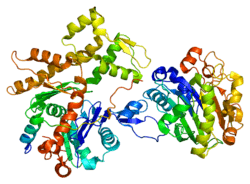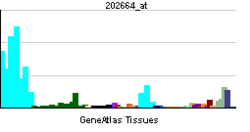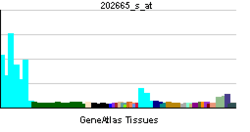WIPF1
| View/Edit Human | View/Edit Mouse |
WAS/WASL-interacting protein family member 1 is a protein that in humans is encoded by the WIPF1 gene.[3][4]
Function
This gene encodes a protein that plays an important role in the organization of the actin cytoskeleton. The encoded protein binds to a region of Wiskott-Aldrich syndrome protein that is frequently mutated in Wiskott-Aldrich syndrome, an X-linked recessive disorder. Impairment of the interaction between these two proteins may contribute to the disease. Two transcript variants encoding the same protein have been identified for this gene.[4] In patients lacking the WIPF1 gene WASp protein levels are depleted and WAS symptoms present.[5]
Interactions
WIPF1 has been shown to interact with Wiskott-Aldrich syndrome protein,[3][6] Cortactin[7] and NCK1.[6] Majority of the mutations causing Wiskott Aldrich Syndrome are located in the WH1 domain of WASp.[8] These mutations affect WASp-WIPF1 binding.[9]
References
- ↑ "Human PubMed Reference:".
- ↑ "Mouse PubMed Reference:".
- 1 2 Ramesh N, Antón IM, Hartwig JH, Geha RS (Dec 1997). "WIP, a protein associated with wiskott-aldrich syndrome protein, induces actin polymerization and redistribution in lymphoid cells". Proceedings of the National Academy of Sciences of the United States of America. 94 (26): 14671–6. doi:10.1073/pnas.94.26.14671. PMC 25088
 . PMID 9405671.
. PMID 9405671. - 1 2 "Entrez Gene: WIPF1 WAS/WASL interacting protein family, member 1".
- ↑ Lanzi G, Moratto D, Vairo D, Masneri S, Delmonte O, Paganini T, Parolini S, Tabellini G, Mazza C, Savoldi G, Montin D, Martino S, Tovo P, Pessach IM, Massaad MJ, Ramesh N, Porta F, Plebani A, Notarangelo LD, Geha RS, Giliani S (January 2012). "A novel primary human immunodeficiency due to deficiency in the WASP-interacting protein WIP". The Journal of Experimental Medicine. 209 (1): 29–34. doi:10.1084/jem.2011089. PMC 3260865
 . PMID 22231303.
. PMID 22231303. - 1 2 Antón IM, Lu W, Mayer BJ, Ramesh N, Geha RS (Aug 1998). "The Wiskott-Aldrich syndrome protein-interacting protein (WIP) binds to the adaptor protein Nck". The Journal of Biological Chemistry. 273 (33): 20992–5. doi:10.1074/jbc.273.33.20992. PMID 9694849.
- ↑ Kinley AW, Weed SA, Weaver AM, Karginov AV, Bissonette E, Cooper JA, Parsons JT (Mar 2003). "Cortactin interacts with WIP in regulating Arp2/3 activation and membrane protrusion". Current Biology. 13 (5): 384–93. doi:10.1016/S0960-9822(03)00107-6. PMID 12620186.
- ↑ Rajmohan R, Raodah A, Wong MH, Thanabalu T (Dec 2009). "Characterization of Wiskott-Aldrich syndrome (WAS) mutants using Saccharomyces cerevisiae". FEMS Yeast Research. 9 (8): 1226–35. doi:10.1111/j.1567-1364.2009.00581.x. PMID 19817875.
- ↑ Rajmohan R, Meng L, Yu S, Thanabalu T (Apr 2006). "WASP suppresses the growth defect of Saccharomyces cerevisiae las17Delta strain in the presence of WIP". Biochemical and Biophysical Research Communications. 342 (2): 529–36. doi:10.1016/j.bbrc.2006.01.160. PMID 16488394.
Further reading
- Ramesh N, Antón IM, Martínez-Quiles N, Geha RS (Jan 1999). "Waltzing with WASP". Trends in Cell Biology. 9 (1): 15–9. doi:10.1016/S0962-8924(98)01411-1. PMID 10087612.
- Antón IM, Lu W, Mayer BJ, Ramesh N, Geha RS (Aug 1998). "The Wiskott-Aldrich syndrome protein-interacting protein (WIP) binds to the adaptor protein Nck". The Journal of Biological Chemistry. 273 (33): 20992–5. doi:10.1074/jbc.273.33.20992. PMID 9694849.
- Stewart DM, Tian L, Nelson DL (Apr 1999). "Mutations that cause the Wiskott-Aldrich syndrome impair the interaction of Wiskott-Aldrich syndrome protein (WASP) with WASP interacting protein". Journal of Immunology. 162 (8): 5019–24. PMID 10202051.
- Vaduva G, Martinez-Quiles N, Anton IM, Martin NC, Geha RS, Hopper AK, Ramesh N (Jun 1999). "The human WASP-interacting protein, WIP, activates the cell polarity pathway in yeast". The Journal of Biological Chemistry. 274 (24): 17103–8. doi:10.1074/jbc.274.24.17103. PMID 10358064.
- Moreau V, Frischknecht F, Reckmann I, Vincentelli R, Rabut G, Stewart D, Way M (Jul 2000). "A complex of N-WASP and WIP integrates signalling cascades that lead to actin polymerization". Nature Cell Biology. 2 (7): 441–8. doi:10.1038/35017080. PMID 10878810.
- Vetterkind S, Miki H, Takenawa T, Klawitz I, Scheidtmann KH, Preuss U (Jan 2002). "The rat homologue of Wiskott-Aldrich syndrome protein (WASP)-interacting protein (WIP) associates with actin filaments, recruits N-WASP from the nucleus, and mediates mobilization of actin from stress fibers in favor of filopodia formation". The Journal of Biological Chemistry. 277 (1): 87–95. doi:10.1074/jbc.M104555200. PMID 11687573.
- Antón IM, de la Fuente MA, Sims TN, Freeman S, Ramesh N, Hartwig JH, Dustin ML, Geha RS (Feb 2002). "WIP deficiency reveals a differential role for WIP and the actin cytoskeleton in T and B cell activation". Immunity. 16 (2): 193–204. doi:10.1016/S1074-7613(02)00268-6. PMID 11869681.
- Scott MP, Zappacosta F, Kim EY, Annan RS, Miller WT (Aug 2002). "Identification of novel SH3 domain ligands for the Src family kinase Hck. Wiskott-Aldrich syndrome protein (WASP), WASP-interacting protein (WIP), and ELMO1". The Journal of Biological Chemistry. 277 (31): 28238–46. doi:10.1074/jbc.M202783200. PMID 12029088.
- Benesch S, Lommel S, Steffen A, Stradal TE, Scaplehorn N, Way M, Wehland J, Rottner K (Oct 2002). "Phosphatidylinositol 4,5-biphosphate (PIP2)-induced vesicle movement depends on N-WASP and involves Nck, WIP, and Grb2". The Journal of Biological Chemistry. 277 (40): 37771–6. doi:10.1074/jbc.M204145200. PMID 12147689.
- Zettl M, Way M (Sep 2002). "The WH1 and EVH1 domains of WASP and Ena/VASP family members bind distinct sequence motifs". Current Biology. 12 (18): 1617–22. doi:10.1016/S0960-9822(02)01112-0. PMID 12372256.
- Volkman BF, Prehoda KE, Scott JA, Peterson FC, Lim WA (Nov 2002). "Structure of the N-WASP EVH1 domain-WIP complex: insight into the molecular basis of Wiskott-Aldrich Syndrome". Cell. 111 (4): 565–76. doi:10.1016/S0092-8674(02)01076-0. PMID 12437929.
- Sasahara Y, Rachid R, Byrne MJ, de la Fuente MA, Abraham RT, Ramesh N, Geha RS (Dec 2002). "Mechanism of recruitment of WASP to the immunological synapse and of its activation following TCR ligation". Molecular Cell. 10 (6): 1269–81. doi:10.1016/S1097-2765(02)00728-1. PMID 12504004.
- Luthi JN, Gandhi MJ, Drachman JG (Feb 2003). "X-linked thrombocytopenia caused by a mutation in the Wiskott-Aldrich syndrome (WAS) gene that disrupts interaction with the WAS protein (WASP)-interacting protein (WIP)". Experimental Hematology. 31 (2): 150–8. doi:10.1016/S0301-472X(02)01023-8. PMID 12591280.
- Kinley AW, Weed SA, Weaver AM, Karginov AV, Bissonette E, Cooper JA, Parsons JT (Mar 2003). "Cortactin interacts with WIP in regulating Arp2/3 activation and membrane protrusion". Current Biology. 13 (5): 384–93. doi:10.1016/S0960-9822(03)00107-6. PMID 12620186.
- Kim MK, Kim ES, Kim DS, Choi IH, Moon T, Yoon CN, Shin JS (Oct 2004). "Two novel mutations of Wiskott-Aldrich syndrome: the molecular prediction of interaction between the mutated WASP L101P with WASP-interacting protein by molecular modeling". Biochimica et Biophysica Acta. 1690 (2): 134–40. doi:10.1016/j.bbadis.2004.06.007. PMID 15469902.




